Hoff is a furniture and home accessories chain with 35 stores in cities across Russia.
How Hoff Generates $1M Monthly from Personalized Marketing Communications
is a furniture and home accessories chain with 35 stores across Eastern Europe. The Hoff website receives upwards of 40 million vists per year and more than 4 million customers pass through its high street stores.
Hoff currently has 2.5 million customers in its database. At approximately 1M USD per month, email marketing accounts for 8.53 percent of total revenue.

Hoff email campaign effectiveness report generated by Maestra for 01.09.17–01.05.18
Hoff’s email marketing philosophy is based on three key principles:
Communications must be personalised
A total of 38 triggered campaigns are constantly poised and ready to respond to customer action or inaction. Every message is personalised based on recipient purchase history and loyalty points balance, and takes into account promotions and availability of goods in the recipient’s region.
Some of the triggered campaigns are designed to encourage content creation and sharing, for example writing reviews and posting pictures of purchases.
40% of revenue from email is generated by triggered campaigns.
Continuous improvement through A/B testing
Hoff’s marketing staff are constantly brainstorming and testing new hypotheses for subject lines, body content, recommended purchases and discounts. They are also continually adjusting drip campaign messages, send frequency and suchlike. Dozens of hypotheses have been tested in the last six months alone.
Proper analysis and measurement of results
Top management at Hoff wants to know exactly how much income is generated by email campaigns without resorting to guesswork to account for competitor activity, state of the market and seasonal variations.
To achieve the required level of certainty, Hoff uses control groups to ensure confident measurement of campaign-generated revenue.
Having a unified reporting system that can gather and consolidate data from multiple sources is another key factor in enabling the correct interpretation and understanding of results.
Since 2015, Hoff has been using Maestra to follow these principles in its marketing activities.
Maestra acts as a central platform for segmentation, reporting and customer data management (online and in-store behaviour and purchasing). It also acts as their email marketing hub, powering regular and triggered campaigns, personalisation and recommended purchases.
Personalised multichannel communication with customers is probably the most effective advertising channel in terms of ROI.
But when you have automated campaigns numbering in the dozens and they all use multiple channels and technologies, you start running into difficulties.
You have to track the effectiveness of each campaign and every adjustment, but you can’t do that with traditional methods like Google Analytics last-click attribution.
We overcame this hurdle by using control groups as a baseline to evaluate the difference between audiences that do and don’t receive communications from us.
This allows us to optimise our investment in communications. We now know exactly what works and what doesn’t, so we can quickly make decisions based on the real impact of every campaign, trigger or adjustment we make to message contents.
Personalised communication
The unified customer profile is the basis for all personalisation. It consolidates information about all interactions between the company and each individual customer — their browsing behaviour, online and in-store purchases, warranty requests and responses to messaging campaigns.
Maestra gathers and consolidates data about all interactions with customers from Hoff’s internal systems — from their Bitrix-powered online store, their Manzana loyalty system and from Axapta, which stores information about all purchases and suppliers.
A deduplication algorithm ensures data integrity. It finds, validates and links data, making sure that each individual customer doesn’t end up with multiple profiles containing different information.
Hoff has a virtually complete portrait of all its customers, with all the data needed for segmenting and generating automated mailings. They can use purchase history, loyalty card number, points balance and region to generate unique and relevant content for each recipient.
Regional personalisation
Centralised data handling allows Hoff to generate emails for all the regions where it operates, taking into consideration local prices and stock availability. For example, a customer in Krasnodar won’t be shown goods that are only available in Moscow, and a customer in Samara won’t be shown prices for Ekaterinburg.
Emails are automatically generated immediately prior to sending without any human intervention from the marketing department. This saves considerable time and resources, as there is no need to create and check multiple email templates for every campaign, and allows the marketing teams to get on with more important tasks.
Frequency personalisation
Hoff divides its customer base into two lifecycle groups — active and lapsing.
For those in the ‘lapsing’ group, Hoff has used Maestra to create automated campaigns that are designed to entice recipients back into the conversation. They ask them to choose which types of emails they would prefer to receive, and how often.
Once recipients have made their choice, they are assigned to the according segment and receive only messages that are appropriate to their selection.
Any customers that don’t respond to the messages about mailing frequency are unsubscribed from mass mailings and are signed up instead for a weekly digest.
The digests are automatically generated with personalised content for each individual customer. They contain recent blog posts, banners and special offers relevant to the customer’s region. The subject line is also generated automatically from blog posts included in the email.
Each customer receives a unique, automatically generated email tailored to their profile.
Continuous improvement of communications
Hoff’s marketing department is constantly coming up with new hypotheses and using Maestra to test them on their audience. Unique emails are created for every mass mailing, and in triggered campaigns the design, text and subject lines are constantly adjusted.
The flow is simple. The marketing department first comes up with a hypothesis, tests it on their audience and then draws conclusions from the results.
Maestra automation allows them to A/B-test campaigns with just a few clicks.
Testing abandoned cart routines
Here’s an example of how Hoff tested a number of hypotheses to optimise the abandoned cart routine.
Hypothesis 1: Email subject affects open rate
The marketing team came up with 10 subject lines for abandoned cart reminder emails and ran a test mailing to see whether some subject lines would result in more opens than others.
This hypothesis was confirmed:
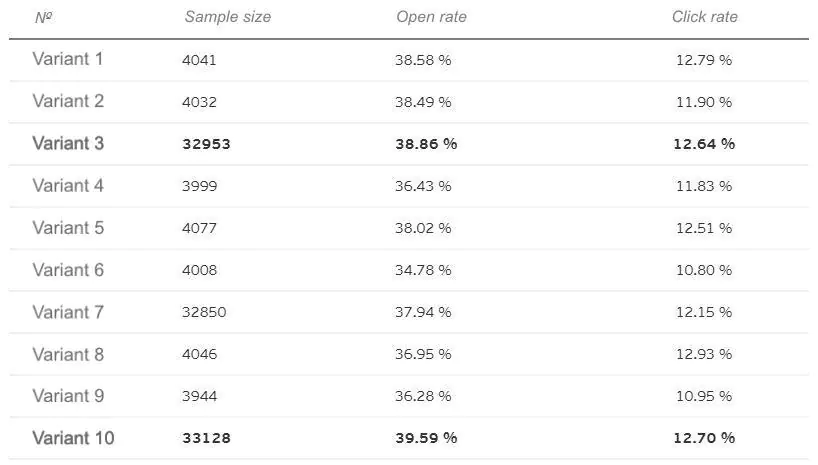
Results of testing email subject line influence on open rate
Hypothesis 2: Conversion will be affected by the number of products in the email and the inclusion of recommendations
The marketing team hypothesised that the conversion rate for an abandoned cart email will depend on the type of information contained in it and how it is presented.
To check their hypothesis they put together 6 different email templates with different blocks and AB-tested them.
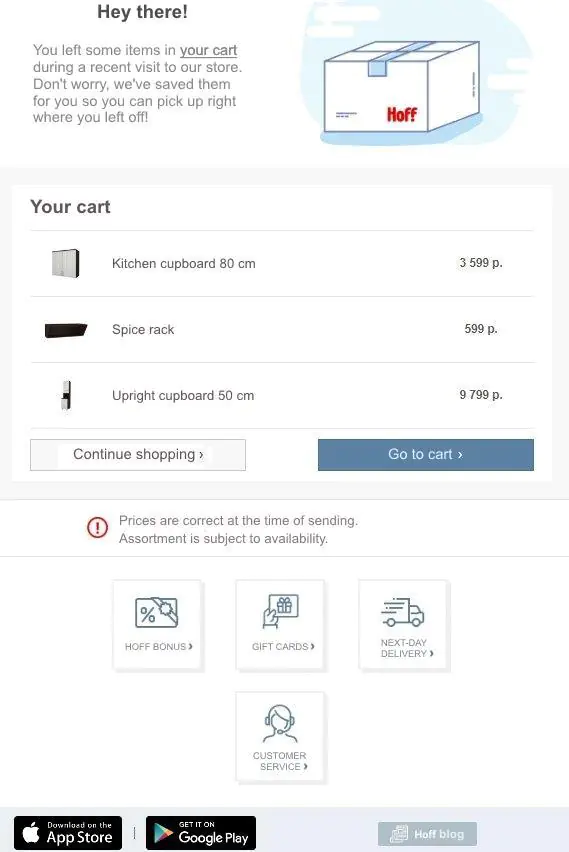
Abandoned cart email variants

Abandoned cart email variants
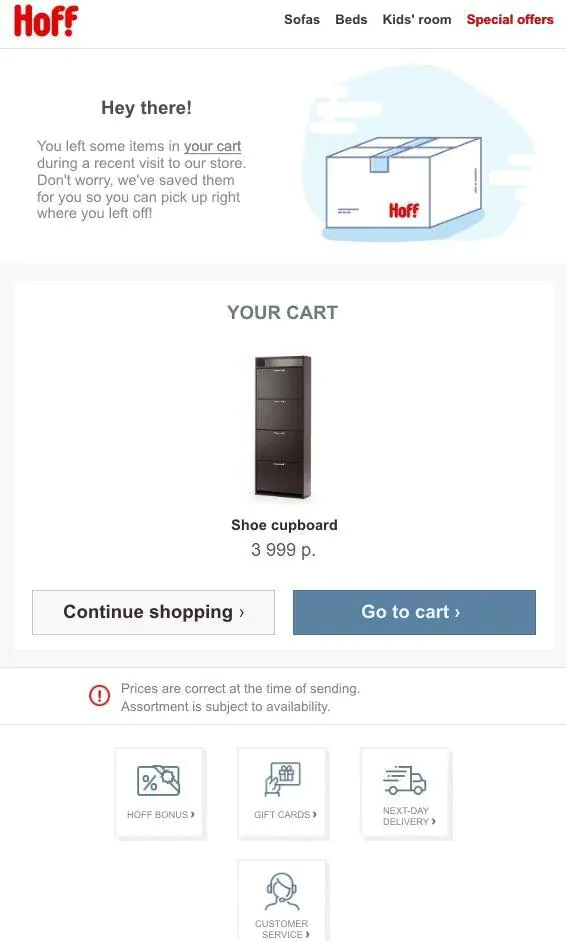
Abandoned cart email variants
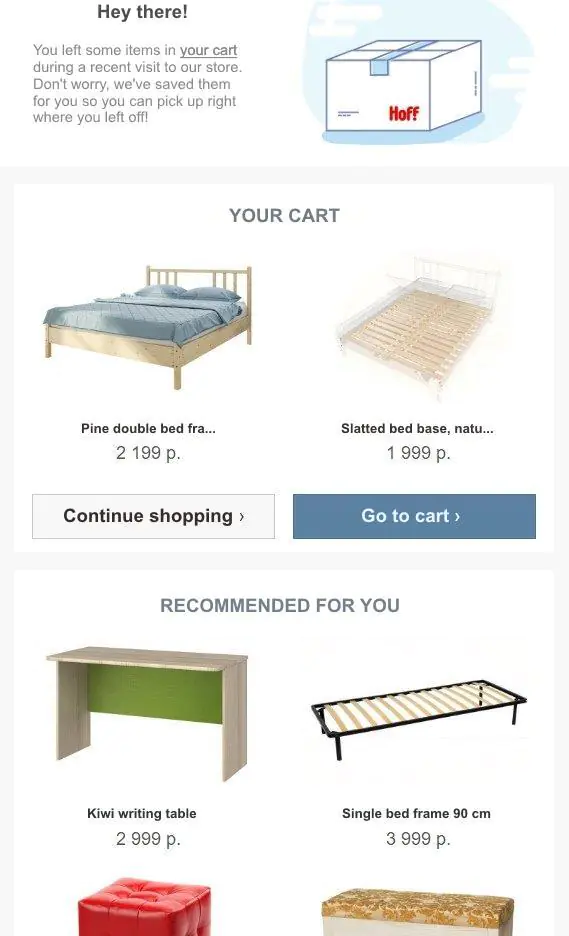
Abandoned cart email variants
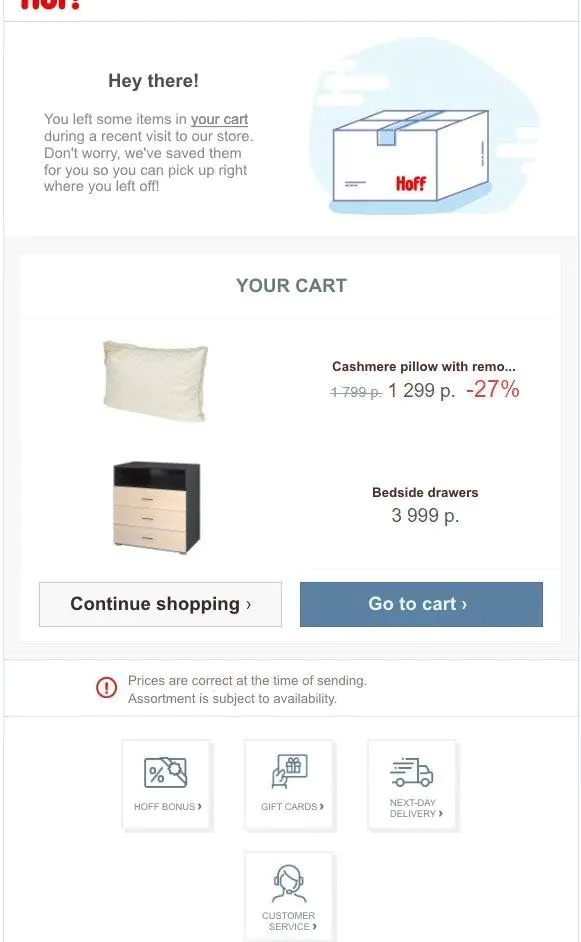
Abandoned cart email variants
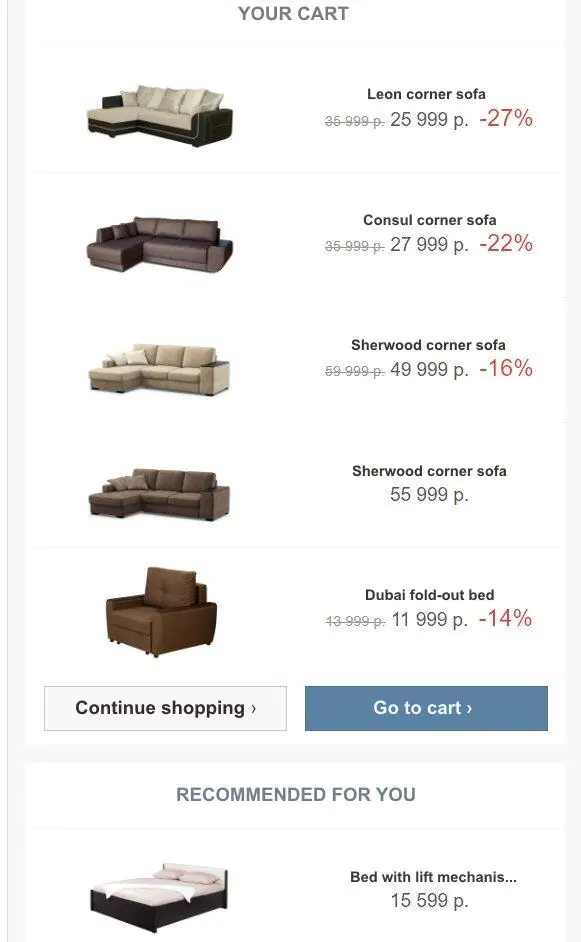
Abandoned cart email variants
This hypothesis was also confirmed. The results showed that conversion is higher in emails without the recommended purchases block, i.e. when there is nothing distracting the customer from their original selection of goods.
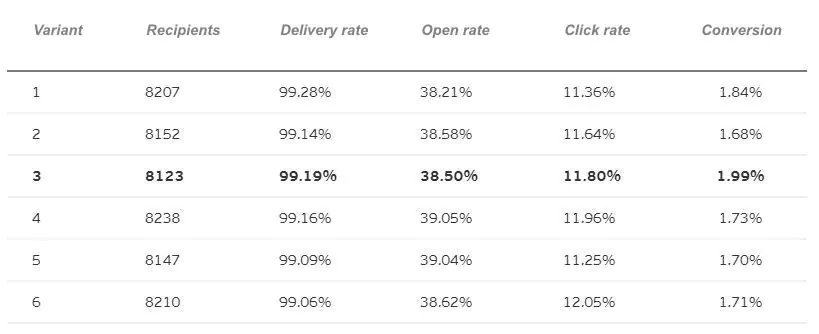
Results of abandoned cart email design AB test
Testing dynamic email body elements
The marketing team investigated whether dynamic elements in the email body can affect conversion rates.
Hypothesis: A countdown timer will increase conversion rates
Hoff sent out a mass mailing prior to a major sale. 23270 customers received an email containing a banner with a countdown timer, while 23372 customers received an email with with the same banner but no timer.

Banner for mass-mailing with countdown timer

Banner for mass-mailing without countdown timer
They used our A/B test calculator to evaluate the results:
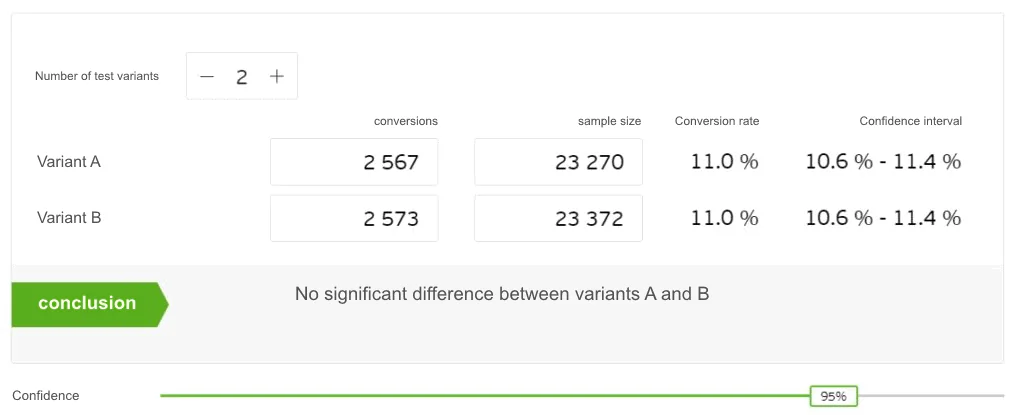
Comparing the results of AB testing with and without a countdown timer
This time the hypothesis was not confirmed. Test results indicate that the conversion rates for both variants are the same. Adding a countdown timer to emails did not increase the conversion rate.
Correct measurement of results
The more complex email marketing becomes, the harder it is to measure. At Hoff there were two main complications in measuring results:
- Reports from high street stores and reports from their loyalty programme were held in different systems. Making a consolidated report required extraction and compilation of data from each system separately.
- The standard method of measurement using Google Analytics didn’t work. It didn’t allow them to see how many points of contact there had been with a customer prior to a purchase, and it didn’t let them see information about in-store sales. For example, if a customer received an email and went online to look at a sofa, and then subsequently purchased it from a high street store, Google Analytics can’t follow the trail.
Single data centre for reporting
Hoff used Maestra to solve the problem with reporting on mass mailings. After the data is processed, Hoff analysts get four types of information about each recipient:
- how the recipient got into the database in the first place;
- the type and quantity of emails sent to the recipient (this information is used in call centres, for example, to see what kind of communication there has previously been with the customer so it can be taken into account in conversation);
- their open rate and click rate;
- the type and name of actions carried out by the customer, including visits to the online store and purchases in high street stores.
This information helps Hoff to interpret customer behaviour correctly, identify customers’ last actions before making a purchase, and analyse prior points of contact with the brand.
Reporting data is compiled and exported automatically.
Using a control group to measure results
Why Google Analytics didn’t work
With Google Analytics it’s difficult to account for a number of factors, for example:
1. If there are dozens of active campaigns running at once and they are constantly being tweaked, it’s impossible to evaluate the added effect of these campaigns and the adjustments that are made to them. You can’t identify exactly whether it was a specific campaign or some other activity that brought about a change in results that you see in Google Analytics.
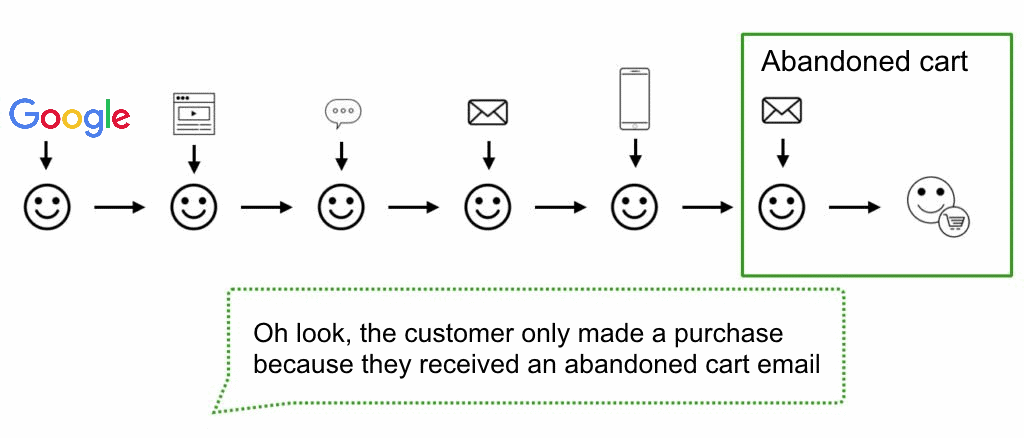
Last-click attribution in Google Analytics
2. It’s impossible to track customers’ actual response to emails. One might click on a link and purchase a sofa straight away, while another might wait until they have a free weekend, then go to a store to have a closer look and make the purchase there.
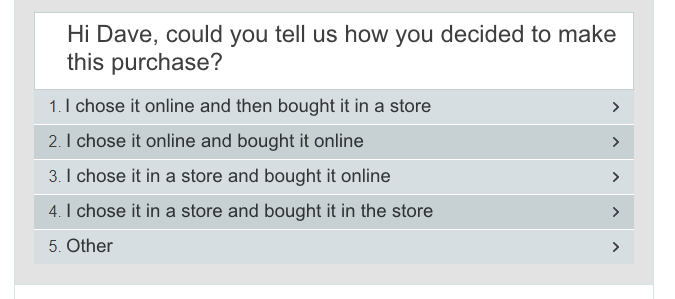
Hoff purchase pattern questionnaire
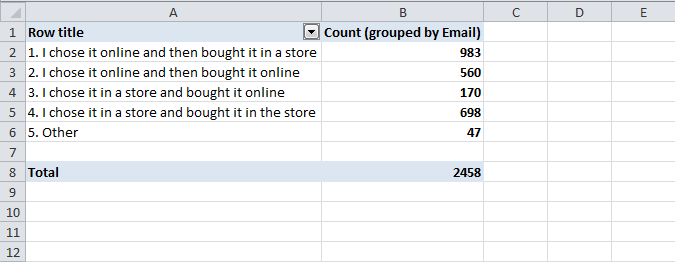
Results of Hoff purchase pattern questionnaire
This is why they use a control group to ensure integrity of results.
How the control group method works
A control group is a small sample of recipients that are excluded from a campaign. Maestra randomly populates the control group once in a set period, for example once a month.
New subscribers that sign up during the period are automatically assigned at random to the control group or to the experiment group.
The control group is created in such a way as to ensure a proper comparison.
At the end of the period or after a campaign is completed you compare the results with recipients who participated in campaigns against those who didn’t. In this way you can reliably confirm whether your email communications have had an effect.
Any relevant metric can be compared, such as average spend, revenue, conversion rate, number of purchases, etc.
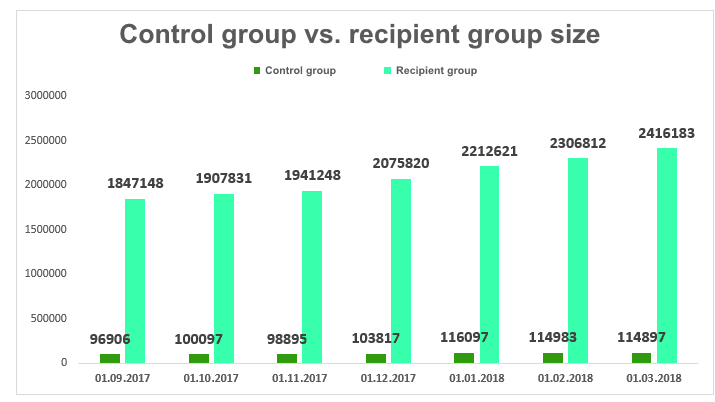
Report on Hoff control vs. recipient group sizes for period 01.09.17–01.04.18
The result
Over the course of three years, Hoff and Maestra have launched hundreds of triggered and mass campaigns based on three key principles:
Personalise your communication — create hundreds of automated targeted campaigns with unique content and offers, personalise each email for its recipient and don’t spam your customers with the same emails over and over again.
Continuously experiment and improve — remember that there is always an optimal way to communicate with every customer, and that it can be found by experiment.
Properly measure effect — use control groups to calculate the added effect and not the absolute effect.
This approach is what led Hoff’s email marketing to bring in an additional 1 million USD per month.
Results like this demonstrate that email marketing, when implemented correctly, can be an extremely effective marketing channel in terms of ROMI.
View from the inside: Impressions of a Hoff marketing manager
Maestra is our first full-featured email marketing tool. We have a lot of customers and we gather a lot of contact details from a number of sources. In the first stage of deployment we set up email address collection in a single database and configured mass mailings and standard triggers. Things took off from there and we launched a lot of projects together over the following three years.
The team at Maestra shares our values of openness, admitting mistakes, giving feedback, adhering to agreements and responding quickly to change. It feels like they’re a part of our own company, as if they’re just in another department somewhere on another floor. The analysts, developers and our personal manager are intimately familiar not only with their own product but also with our project.
Our manager at Maestra has a global view of the situation and suggests improvements, points out bottlenecks and makes sure that the project runs smoothly and profitably. Over the course of our work together we’ve deployed a lot of changes, large and small, and the project has become quite complex.


